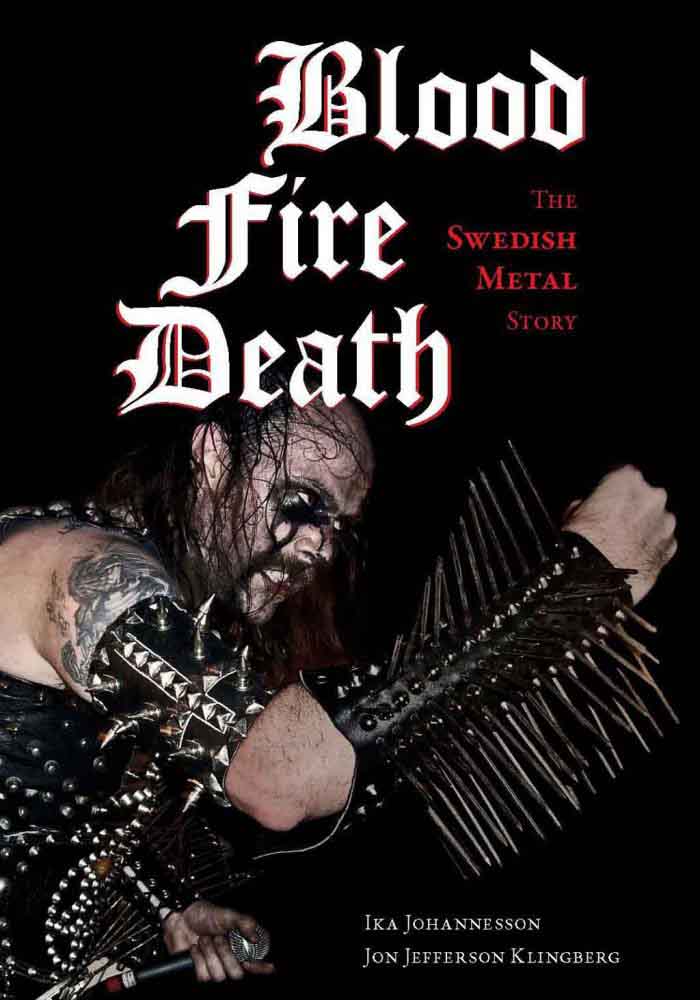Blood Fire Death: The Swedish Metal Story
by Ika Johannesson and Jon Jefferson Klingberg
240 pages, Feral House, $19
As we get past the glory years of underground metal — roughly 1987 to 1994 — more histories are emerging such as Blood Fire Death: The Swedish Metal Story which came out two years ago and presented itself as a history of Swedish underground metal. It achieves that and more, but falls short of its ultimate mission, which is to explain Swedish death metal and black metal, world-renowned for their intelligence and intensity.
Like most books of its nature, this one constructs itself from interviews with some of the people involved in the scene, and these can be divided into two groups: the relevant and the irrelevant. The book starts off with an interview with Nifelheim, who while universally recognized as good guys, are not important to the scene, nor really death metal, since their music is more like a fast heavy metal band with death metal vocals.
From there it moves to looking into Bathory, giving great insight into the real grandfathers of all extreme metal in Scandinavia, and earns a place on a serious metal bookshelf for this alone. Having done the groundwork, Blood Fire Death: The Swedish Metal Story branches out to explore other death metal and then black metal bands, before trying to cap it off with coverage of the late 1990s.
Where it has interviews with the characters involved with the formative years of these subgenres, this book shines and offers a number of moments of quality insight into characteristics of underground metal — its obsession with being true, its cold anti-empathy and cerebral anti-social tendencies, its awkward youthfulness and opposition to what modern adulthood has become, and the ability of heavy metal fans to manipulate their own emotions in order to become more realistic and therefore more powerful — which could each be a book in their own right. It is a necessary but not sufficient part of the Swedish underground metal story, which must in turn be told in the context of the Scandinavian and Nordic underground metal stories, the story of underground metal itself, and its context within heavy metal, rock, popular culture, and post-Enlightenment™ political developments like modernism and postmodernism.
As a narrative, it leans toward the postmodern, making observations but refusing to really draw any kind of unifying thesis or observational conclusion from what it has found; instead, it shows us glimpses, scenes, and personae within a scene that is assumed to already be familiar to the reader. In this we see the weakness of this book: it appeals to True Believers only, and is not a very good general introduction, which means that no one will pick this up and find a reason to investigate Swedish metal, especially not after chapters on less important bands or bands which really are not underground metal like Hammerfall and Nifelheim.
It has a number of other glitches we can identify: it covers only a few interview subjects, so slants in that direction; it does not achieve any broader context in death metal and black metal as artistic movements; it does not get much or coherently into the motivation behind all this, since most musicians are inarticulate; it is poorly edited. Its strength is in its specificity and independence from a thesis, but its weakness comes from being peripheral and therefore, not really giving us any entry point except as already-rabid Swedish death metal fans. On top of this, it includes a few inconsequential chapters about underground metal after the mid-90s, women and marginalized people in metal, and some of the later history to bands like Entombed. A good hard edit would remove about a third of the book and replace it with more general information on Swedish underground metal and underground metal in general.
Whining aside, Blood Fire Death: The Swedish Metal Story presents a solid and clear primary-source view of the highlights of much of Swedish underground metal, and for that, it serves as required reading for metalheads who have discovered this exquisite corner of the heavy metal genre and its underground metal subgenres. Just about anyone can appreciate the coverage of Bathory, Mayhem, and Entombed that it provides, and a casual reader can get a basic grasp of why underground metal occurred, what it wanted to express, and why it faded away.
Tags: Bathory, entombed, mayhem, Sweden, Swedish Black Metal, Swedish Death Metal, swedish metal, underground metal



Does this need really to exist after Ekaroth’s comprehensive Swedish Death Metal Book from the 2000’s?
I noticed some disparities in coverage, so this would be a supplement. Ekeroth’s book was not intended as a comprehensive one either, but a view of his experience of a scene. Very gonzo.
What dudes in Mayhem, Bathory, or Enyombed were Swedish?
Mayhem: Dead
Bathory: Quorthon + Boss + most studio musicians
Entombed: most of them
Based on this review, I will probably check this out from my library rather than buy it. After Adam Parfrey died, Feral House went to pot. Uncle Ted and David Cole were purged from its catalog by the wannabe Vice rejects that took over. This is another reason why I’m inclined to not purchase this book. A damn shame when you consider that Adam Parfrey was at the vanguard of free speech in publishing during the nineties.
Interesting history. They need to spend a little more effort on copyediting, at the very least.
Excellent review, very much appreciated.